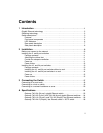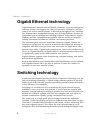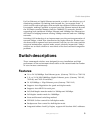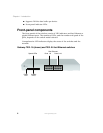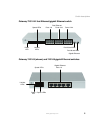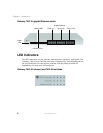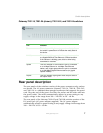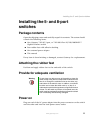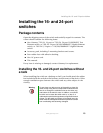3
Switch descriptions
www.gateway.com
For Fast Ethernet or Gigabit Ethernet networks, a switch is an effective way of
eliminating problems of chaining hubs beyond the “two-repeater limit.” A
switch can be used to split parts of the network into different collision domains,
for example, making it possible to expand your Fast Ethernet network beyond
the 205-meter network diameter limit for 100BASE-TX networks. Switches
supporting both traditional 10Mbps Ethernet and 100Mbps Fast Ethernet are
also ideal for bridging between existing 10Mbps networks and new 100Mbps
networks.
Switching LAN technology is an improvement over the previous generation of
network bridges, which were characterized by higher latencies. Routers have
also been used to segment local area networks, but the cost of a router and the
setup and maintenance required make routers relatively impractical. Today’s
switches are an ideal solution to most kinds of local area network congestion
problems.
Switch descriptions
These unmanaged switches were designed for easy installation and high
performance in an environment where traffic on the network and the number
of users increase continuously.
Features
■ 16 or 24 10/100Mbps Fast Ethernet ports. (Gateway 7201-16 or 7201-24)
■ 5, 8, or 24 10/100/1000Mbps Gigabit Ethernet ports. (Gateway 7401-05,
7401-08, and 7401-24 switches)
■ 24 10/100Mbps + 2Gps Ethernet ports (Gateway 7201-24.2)
■ Supports Auto-Negotiation for speed and duplex mode.
■ Supports Auto-MDIX for each port.
■ Full-/half-duplex transfer mode for 10Mbps and 100Mbps.
■ Full-duplex transfer mode for 1000Mbps.
■ Store-and-Forward switching method.
■ IEEE 802.3x flow control for full-duplex mode.
■ Backpressure flow control for half-duplex mode.
■ Integrated address Look-Up Engine, supports 4K absolute MAC addresses.




